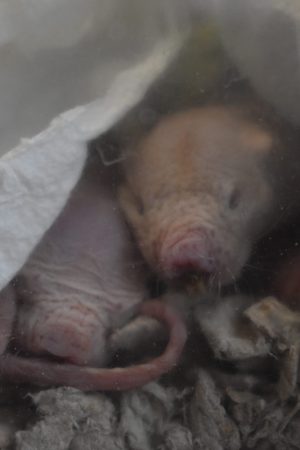

Meet the new faces in the Small Animal Building
You can now see pouched rats, naked mole rats, and chuckwalla hatchlings.
Hogle Zoo’s team is excited to welcome new residents to the Small Animal Building. Make sure to visit them during your next visit!
Southern giant pouched rats
Commonly found across Africa, southern giant pouched rats are nocturnal and use a vast system of tunnels and hollow trees for their nest. They are intolerant to hot temperatures, so these tunnels help keep them cool from the savanna heat in the daytime.
Pouched rats are social animals, living in colonies up to 20 individuals. They can easily adapt to any situation and are excellent climbers and swimmers. Pouched rats are not true rats. They are in a different rodent family and get their name from their ability to store food in their hamster-like cheeks.

Pouched rats are true wildlife champions!
Pouched rats have an acute sense of smell, helping them find food and even detect explosives. Known as hero rats, pouched rats train to detect explosives starting at four weeks of age when their olfactory receptors become fully developed. They are exposed to various sights and smells and learn to associate a clicker sound with food as a reward. Once they learn this behavior, the pouched rat is trained to indicate a hole that contains explosive material by nosing it for 5 seconds. Once trained, these pouch rats are exceptional in locating landmines and helping with search and rescue teams during natural disasters. Their small stature gives them an advantage over their K9 counterparts.

Naked mole rats
What’s the sitch? Naked mole rats are found in the eastern regions of Africa, where they live exclusively underground in burrows and tunnels. Mole rats can live in large eusocial colonies of 70 or more individuals governed by a queen who is the sole breeder and is constantly moving and inspecting tunnels to exert dominance over the other mole rats to maintain charge.
Naked mole rats are characterized by their “naked” pink skin and little sensory whiskers on their faces and toes that sweep soil as they move throughout the tunnels. They have no external ears, small eyes, and distinct large teeth used to dig tunnels with powerful jaw muscles and large incisors.
Uniquely, the naked mole rat’s typical life expectancy can be between 10-30 years (an unprecedented amount of time compared to other small rodents), making them the longest-living rodents in the animal kingdom. Scientists believe their high amount of protein intake replenishes damaged proteins within their cells to keep them healthy much longer than a typical cell.
Naked mole rats are likely the only mammals with these molecular adaptations that scientists can study. The hope is naked mole rats will give hope to humans who have cancer or other neurological diseases such as Alzheimer’s or Parkinson’s disease.
Chuckwalla hatchlings
Our teams successfully incubated Chuckwalla eggs, and on August 29, 2024, five Chuckwallas hatched.
While not threatened by predators or human intervention, Chuckwallas are an important part of Utah’s desert ecosystem. They are commonly found in Utah along rocky hillsides and rocky outcroppings in the desert. Chuckwallas are at home in the sun, often lying flat on desert rocks that help them absorb heat and stay camouflaged.


